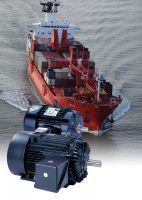Regal Helps Give a Motor its Sea Legs
It is a sobering thought that the seas make up over seven-tenths of earth’s surface – or put another way, three-quarters of the planet is viscously hostile and corrosive to electrical engineering installations. Here, Jerry Hodek, technical and operations director, Regal Beloit EU looks at some of the principles and techniques that have evolved to make motors reliable at sea. If you try to look up ‘marine specifications for electric motors’ on Google or in a library, the chances are that you will be met with a tsunami of specifications, international standards, specialist industry standards and impenetrable technical documents. The truth of the matter is that electrical engineering in a marine environment is based on exactly the same scientific principles as land-based engineering. However, the sea is such a harsh environment that robust protection measures have to be put in place – and then maintained alongside the electrical installation.
It is not surprising that a plethora of standards have evolved to address the special needs of marine electrical engineering. There are international standards, national standards, standards for special situations and insurance requirements. And of course if you are looking at a warship, there are naval standards too. Understanding which standards apply in any given situation is half the battle! Many of the technical details of the various standards are encompassed in IEEE 45, Recommended Practice for Electrical Installations on Shipboard. The main requirements can be summarised as follows:
• Class B or Class F Insulations are usually adequate to resist the oil and moisture atmospheres likely to be present at sea.
• Above-deck motors must be of cast-iron construction and totally enclosed design.
• Further, above-deck motors need to be corrosion-resistant, with well-fitting gaskets, no nooks where water can collect, well lubricated to repel moisture and salt, etc.
• Greases in general are used rather than oil, as it will not leak when the ship pitches and rolls.
• The nameplate may need to include more technical details than a motor used on land, e.g. full load speed.
• Below-deck motors need comprehensive corrosion protection including non-rust, metal-plated or epoxy-painted parts as appropriate, stainless steel nameplate, resin and hardener or equivalent coating on the rotor.
• Boiler room motors must be explosion-proof and run cool in operation (which may be achieved by using an oversized motor). Comprehensive details are required on the nameplate.
• Many motors will need to be fitted with a rodent screen.
• Winch and hoist motors may be required to have high starting torque capabilities.
Example
The design of a specific marine duty motor, the Marathon Electric’s Blue Chip XRI, can now be analysed to see how motor makers address the needs of their maritime clients. The Blue Chip motors are designed to meet both the U.S. Coast Guard requirements and IEEE 45 specifications for marine duty motors. They are based on a totally enclosed, severe duty, cast-iron construction. Epoxy coatings are used to protect against the harsh environment. Rugged die-cast aluminium rotors are precision-balanced to reduce vibrations. Horsepower ranges from 3/4 to 350 hp as stock ratings, and up to 600 hp for special order.
Typical applications include capstan drives, cargo winches, jib cranes, circulating pumps, compressors, fire pumps and ventilation fans. Blue Chip motors are inverter-rated and their insulation combines corona-resistant magnet wire and a low stress winding configuration. They exceed many environmental protection and energy efficiency requirements such as the American NEMA Premium efficiency levels.
The bearings are oversized and designed and engineered for continuous, reliable performance and easy maintenance. They incorporate a high-temperature-based grease, while generous grease inlets provide ease of maintenance. Shaft seals prevent entry of contaminants into the bearings. The motors are certified for Division II Hazardous Locations, UL Recognized and CSA Certified. Marine motors are fundamentally the same as industrial motors, but every detail of the design is optimized for reliability and robustness.





 Power Transmission Engineering is THE magazine of mechanical components. PTE is written for engineers and maintenance pros who specify, purchase and use gears, gear drives, bearings, motors, couplings, clutches, lubrication, seals and all other types of mechanical power transmission and motion control components.
Power Transmission Engineering is THE magazine of mechanical components. PTE is written for engineers and maintenance pros who specify, purchase and use gears, gear drives, bearings, motors, couplings, clutches, lubrication, seals and all other types of mechanical power transmission and motion control components.